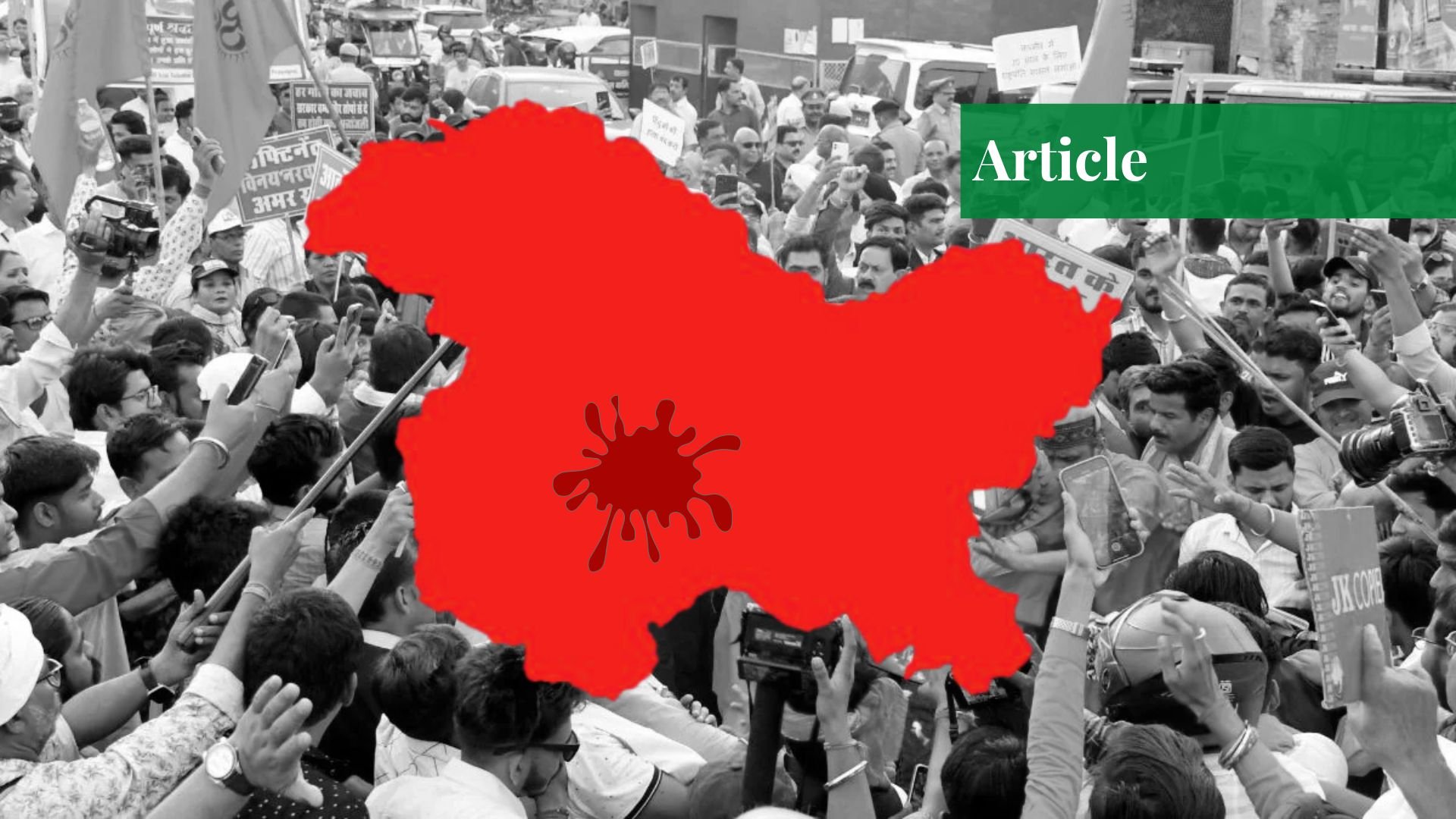On April 22, 2025, the tranquil valley of Pahalgam, renowned for being a mirror of the picturesque topography of Indian Illegally Occupied Jammu and Kashmir (IIOJK), was colored with the blood of a civilian massacre. As the dusk cloaked, an open fire shattered the calm, soaking the valley in tragedy. Unidentified militants opened fire at a private tour bus carrying non-Muslim tourists and civilians. Within fifteen minutes, 28 civilians were dead and 20 were seriously injured. For India, it is the biggest attack on the civilian community after the Mumbai attack.
Initial reports suggested that the masked terrorists used automatic weapons to immobilize the bus, target the driver, shoot the passengers, and then demand ID cards that reflected religious profiling. The Resistant Front (TRF) claimed to be the force behind the attack, framing the massacre as a warning to “settlers” and “agents” trying to bring about demographic change in IIOJK. India has perceived it as an act of external aggression and conspiracy and has handed the case to the National Investigative Authority (NIA).
New Delhi has controversially announced the unilateral end to the Indus Water Treaty, purely symbolizing that India is once again unjustly blaming Pakistan for illegal militant actions within their jurisdiction. The statement of militant actions does not require soft diplomacy, and abruptly ending the treaty and closing the Attari border shows a disturbing escalation of regional brinkmanship. This tragic accident has led to a further tightening of bilateral relations between India and Pakistan, leading to a diplomatic deadlock.
The Legal Fault Lines: The Crisis beneath the Constitution
The Pahalgam attack did not occur in a legal vacuum. It unfolded in a region where law is both wielded as a weapon and sought as a shield. India’s first legal response, the invocation of the Unlawful Activities (Prevention) Act (UAPA), is quite predictable. Under Section 15, the Pahalgam massacre qualifies as a “terrorist act”; however, UAPA’s long detention periods, vague definitions, and low conviction rate (2.2% in 2021) raise concerns about equitable delivery of justice. Moreover, the NIA Act allows New Delhi to intervene in terror cases without state consent.
The swift transfer of the Pahalgam case to the NIA shows a push to centralization of power, creating a chilling effect in the region of IIOJK. The main problem is not the transfer but the lack of transparency in NIA’s procedure, which mirrors an assertion over IIOJK’s territory rather than a commitment to justice.
Article 21 of the Indian Constitution guarantees “Right to Life,” but in IIOJK, this right is undermined in every way possible. Victims of the Pahalgam attack had no security escort, no surveillance system, and no emergency helpline at the time of the attack. In the case of NHRC v. State of Arunachal Pradesh (1996) 1 SCC 742, the Indian Supreme Court held that “the state is constitutionally bound to protect the life and liberty of every person, including non-citizens like the Chakmas. Public hostility cannot justify abdication of this duty under Article 21.”
The same standard is applicable here. Under international human rights law, if credible evidence of selective state security enforcement is found, like in IIOKJ’s region, then it can be a potential violation of Article 9 ICCPR, i.e., a breach of the right to security. At the same time, India alleges cross-border sponsorship, unjustly blaming Pakistan for the tragedy despite its failure to provide adequate security. As per the case Nicaragua v. USA, 1986 ICJ Rep 14, mere allegations without concrete proof are not sufficient to hold a state responsible.
Weaponizing Water? The Treaty Gambit after Pahalgam
In the wake of the Pahalgam attack, India once again has resorted to the suspension of the Indus Water Treaty (IWT). The Indian Ministry of External Affairs announced that India is suspending IWT, closing the Attari border checkpost, and banning Pakistani travelers from entering India. Pakistanis already present in India under the SAARC Visa Exemption Scheme have 48 hours to leave the country, and defense personnel at the Pakistani High Commission in India have a week to leave the country.
Amongst all these, the announcement of the suspension of IWT is more of a targeted one than a practical one. IWT is one of the longest-standing treaties between Pakistan and India, brokered by the World Bank. It is a binding international treaty under the Vienna Convention on the Law of Treaties (1969). Article 26 of the Vienna Convention (pacta sunt servanda) binds both states to follow this treaty in good faith. Article 7 of the IWT mandates cooperation and agreement even in tense political situations like the Pahalgam attack.
Legally, no provision in IWT allows the unilateral suspension or abrogation of the treaty by either party. There is no exit clause in the treaty, and any change in the treaty requires the consent of both parties. Ambassador Maleeha Lodhi noted that India’s announcement is followed by a lot of uncertainties. Moreover, it was evident that India wanted to walk out of this treaty, as in January 2023, India talked about its dissatisfaction with the treaty’s dispute resolution provisions, and in August 2024, it formally sent a notice to Pakistan, wanting to review the treaty, but all of this seems like an alibi to wiggle out of IWT.
Amidst all these geopolitical escalations, PM Mohammad Shehbaz Sharif convened the meeting of the National Security Committee on Thursday, April 24. Following the meeting, Pakistan has responded with strict diplomatic and strategic measures. Consistent with its longstanding position post-Mumbai attacks, Pakistan reaffirmed that any suspension of the IWT will be considered an act of war.
Moreover, Pakistan has announced the suspension of all bilateral agreements and trade relations with India and has immediately closed its airspace for all Indian airlines. Pakistan, in addition to the immediate closure of the Wagha border, issued a visa cancellation notice for all Indian nationals under SVES. Moreover, NSC declared Indian defense, naval, and air advisors in Islamabad persona non grata and directed them to leave Pakistan not later than April 30, 2025. A notice to reduce the strength of the Indian High Commissioner in Islamabad to 30 diplomats is issued, which will take effect from April 30, 2025.
Theories Behind the Bloodshed: Layers of Blame and Possibility
In the immediate aftermath of the Pahalgam crisis, The Resistance Front (TRF) came forward and claimed responsibility for the attack. In their statement, they declared the attack to be perceived as a grave warning to the state and settlers who are actively trying to change IIOJK’s demography. Despite this claim, Indian authorities swiftly pointed fingers towards Pakistan for cross-border support, supposedly through military proxies like Lashkar-e-Taiba. However, no credible evidence has been found regarding Pakistan’s involvement in the massacre. Critics are arguing that India’s attempt to internationalize the blame, especially towards Pakistan, without any credible proof, is a suggestion of political convenience. While Pakistan has firmly denied any involvement, India is adopting a hostile approach, saying, “If blood will flow, the water won’t.” These aggressive and swift diplomatic measures, without credible evidence, especially the announcement of the suspension of the IWT, are being perceived as an alibi to end the six-decade-long treaty.
On the contrary, a major, deeply controversial theory has emerged claiming the tragedy was a false flag operation by the BJP. Opposition voices within India, independent journalists, and analysts have questioned such prompt political response, including the swift transfer of the case to the NIA and the unilateral suspension of IWT without proof. Some are even suggesting that this act is a publicity stunt by the BJP to cash out on public sentiment and support in the upcoming general elections, just like how they did with the Pulwama attack in 2018. Simultaneously, another school of thought views the tragedy through the lens of internal resistance due to the revocation of Articles 35A and 370. Thus, this incident can be seen as an expression of internal resistance rather than foreign manipulation.
The attack was followed by accusations lacking credibility, as the evidence does not add up. The distance between Pahalgam and the Line of Control (LoC) is 100 to 120 kilometers and is covered with the challenging terrains of the Pir Panjal Range, making infiltration to Pahalgam logistically impractical. Moreover, it requires crossing one of the world’s highly militarized borders, the LoC, which is nearly impossible without activating Indian surveillance systems.
Additionally, Indian media and officials immediately blamed Pakistan without any forensic analysis, intelligence report, or investigation. Pahalgam massacre raises suspicion of being a false flag operation of the BJP, widely known for fueling anti-Pakistan sentiment before elections, just like they did in the 2019 Pulwama attack. TRF came forward as the real perpetrators, yet India continues to ignore this. Therefore, India’s accusation first and facts later strategy is merely to divert
attention from the IIOJK’s internal instability, to galvanize the voter base, and avoid scrutiny of its intelligence failure.
Conclusion
In a nutshell, any civilian massacre driven by any motive is a grave violation of international humanitarian law and the fundamental right to life protected by the Constitution. Therefore, no explanation can be given for such a horrendous act of targeting unarmed civilians. Justice must prevail, but it should not be at the cost of diplomatic hysteria or regional destabilization. India should learn from this tragedy and must take the deemed steps to fulfill its obligations under Article 21 of the Indian Constitution. Moreover, India must reconsider its unilateral announcement of the revocation of the IWT, as it would do nothing except tighten relations between both countries. Therefore, steps must be taken to ensure justice without unjustly pointing fingers at others. Justice must be pursued not through reactionary blame games but through accountability, transparency, and regional responsibility.
If you want to submit your articles and/or research papers, please visit the Submissions page.
To stay updated with the latest jobs, CSS news, internships, scholarships, and current affairs articles, join our Community Forum!
The views and opinions expressed in this article/paper are the author’s own and do not necessarily reflect the editorial position of Paradigm Shift.
Areeba Imran is a third-year law student at Pakistan College of Law with a focused interest in constitutional law, environmental law, and the emerging field of space law. She serves as the general secretary of the Environment and Law Society and has interned at the Advocate General’s Office. Through her writing, Areeba aims to contribute to nuanced legal discourse on both national and global platforms.



